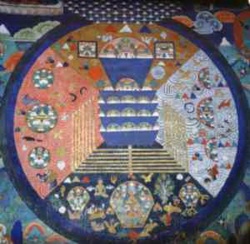Three periods, teachings of the
three periods, teachings of the
[三時教] (Jpn sanji-kyo )
Also, three periods. A classification of Shakyamuni Buddha's teachings developed respectively by the Dharma Characteristics (Chin Fa-hsiang; Jpn Hosso) school and the Three Treatises (Sanlun; Sanron) school. This system arranges Shakyamuni's teachings into three categories according to the order in which these schools thought they were preached and their content.A classification by the Dharma Characteristics school based on the Revelation of the Profound Secrets Sutra explains that the first period corresponds to the Hinayana, or Agama, sutras. During this period, the Buddha taught the four noble truths to refute attachment to the self, or ego. He explained that, though the dharmas, or elements of existence, are real, the self is without substance. The second period corresponds to the Wisdom sutras, which teach that all things are non-substantial and refute attachment to belief in the reality of the dharmas as taught in the Agama sutras. The third period corresponds to the Flower Garland Sutra, the Revelation of the Profound Secrets Sutra, and the Lotus Sutra. The teachings of this period refute attachment both to the idea that the dharmas are non-substantial and to the belief that they are real. They teach that the dharmas are neither real nor non-substantial; this is called the Middle Way. The teachings of the first two periods are regarded as temporary and imperfect, while those of the third period are considered to reveal the truth.According to a classification by the Three Treatises school, the first period is that of the Hinayana teachings, which explain that both the mind and the objects it observes (objective reality) are real. The second and third periods constitute that of the Mahayana teachings; the teachings of the second period state that the mind alone is real, and those of the third period, that both the mind and its objects are without substance. The Three Treatises school asserts that only the teachings of the third period are complete and final in meaning.
